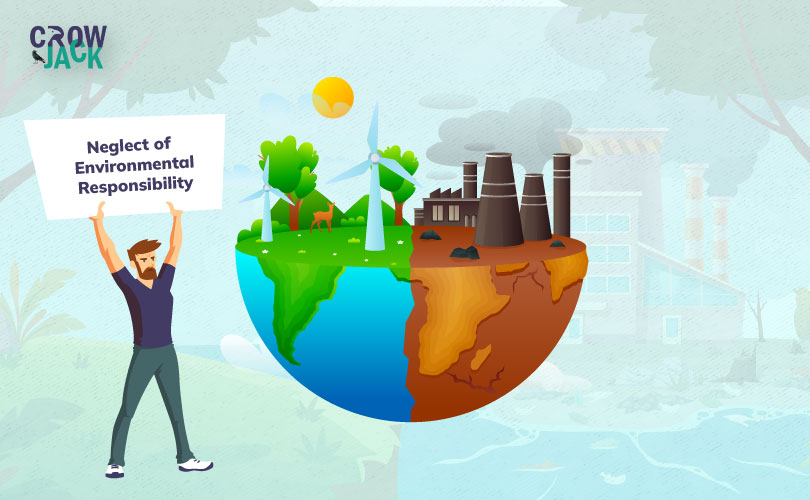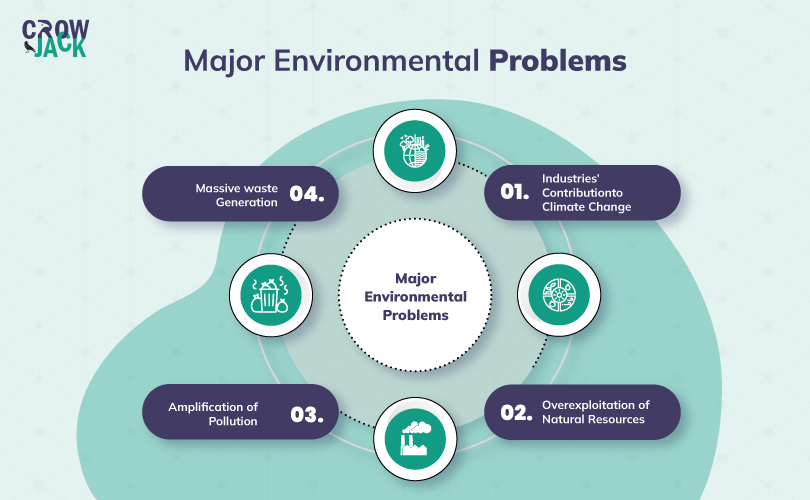Overview of neglect of environmental responsibility
One of the greatest ethical dilemmas that businesses often encounter is to make the tough choice between acting environmentally responsible or exploiting an opportunity at the expense of the environment. Subsequently, a large number of businesses often neglect the need to comply with environmental ethics to succeed in their strategic SMART Goals. This explains why businesses are among the major contributors to environmental problems paralyzing the planet. To substantiate, as per The Guardian, only 100 companies in the world account for 70 percent of the world’s greenhouse emissions. This explains the gravity of business organizations’ neglect of the need to be environmentally responsible.

What is the environmental responsibility of businesses?
Corporate environmental responsibility is defined as the ethical obligation that businesses have to adhere to in order to preserve natural resources from any sort of environmental harm. This implies that the environmental responsibility of businesses is to develop a foolproof strategy that includes different initiatives that can comply with reducing energy consumption, promotion of recycling initiatives and utilizing eco-friendly processes of production.
Furthermore, many businesses fail to recognize that, while promoting sustainability in business may cost a little more, it also brings many benefits that can assist in escalating the business's growth.
To substantiate, according to a recent study, more than one-third of the population is willing to pay more if they get more sustainable products or services. Out of the population, GenZ(39%) and Millenials made their way to the highest share as compared to GenX(31%) and Baby Boomers (26%) that are willing to pay more for matching their values related to sustainability. Along with the profitability, promoting sustainability can also build a positive reputation of the company for showcasing the care for the environment along with earning profits. Hence, it has become vital for employers to hop on the green trend to cope with the contemporary world.
However, in the race of earning maximum profits, many businesses are adversely affecting the environment in one way or another. Hence, the further section will shed light on the major environmental problems that businesses are largely responsible for
Table of Contents
Major Environmental Problems

1. Industries’ contribution to climate change
In all the processes of manufacturing to deliver the final product to consumers, lots of greenhouse gasses causing harm to the environment are emitted by the businesses. Since the Industrial Revolution, the level of CO2 has risen more than 40% and is now higher than it has been in the last 800,000 years. Despite the fact that many companies are taking various initiatives to reduce the emissions of multiple greenhouse gasses, there is still a lot of work to be done to reduce the level and protect the climate around the world.
2. Overexploitation of natural resources
Natural resources are the beginning of any product or supply chain in any industry, Hence, maintenance of these natural resources is very crucial to continue the operation of the earth. However, many businesses are failing to manage the natural resources of the earth and because of them, every business around the globe will have to pay the price in the future. The World Wide Fund for Nature (WWF) states that if humans continue to over-exploit the natural resources the same way they are doing today, then it will require 2.5 planets in 2050 to fulfill the demand for natural resources.
3. Amplification of pollution
Many traditional environmental issues such as dumping industrial waste into water bodies, reckless cutting of trees to set up new industries, and increasing emissions of greenhouse gasses, many businesses are responsible for increasing the level of multiple forms of pollution around the globe.
4. Massive waste generation
Waste generation has been one of the most crucial problems around the globe. And businesses are majorly responsible for generating huge chunks of waste every year. To substantiate, 13 tons of dangerous waste affecting the environment and humans are produced every second and that can contribute up to 400 million tons per year. Furthermore, it is noteworthy that the construction industry is the largest generator and generates almost 90% of waste all around the globe. The various types of waste that are generated by various industries are mentioned below-
- Chemical Wastes- Chemical wastes are the different harmful chemical residues that when disposed of, affect the environment negatively. Chemical manufacturing, paper manufacturing, paint manufacturing, and pharmaceutical industries are among the biggest culprits.
- Solid Wastes- Solid waste like papers, cardboards, scraps, and metals are included in the solid wastes. As stated above, the construction industry is among the largest contributors to solid waste generation in addition to the packaging industry, metallurgy industries, and printing industry.
- Toxic and Hazardous- Nuclear wastes, radioactive wastes, and explosives waste are some common types of toxic and hazardous wastes generated by multiple industries. The leather and textile industry is the largest contributor to generating toxic and hazardous waste.
- E-waste- Multiple discarded items from electronic or electrical waste are referred to as E-waste. The electronics and appliances industry is among the largest contributors to electronic waste generation.
- Surgical wastes- Syringes, gloves, or any type of waste generated by the medical industry is referred to as medical waste. Hospitals, laboratories, the pharma industry, clinical testing units, and the veterinary industry generates the largest share of surgical waste.
Measure to deal with Environmental Responsibility
Probing further, among the ethical dilemma of choosing between the profits of the company and environmental sustainability, many companies choose to stay ethical and are ready to take various initiatives to maintain sustainability all around the globe. In that case, the further section focuses on various steps that can be taken by the employers to deal with the ethical issue of environmental responsibility.
1. Identifying the major environmental issues in the industry
Different industries have different environmental problems. Hence, the first step that businesses need to take is to determine the environmental problems that are corresponding to their industry and then initiate specific plans of action to counter each environmental problem. For instance, in the quick-service restaurant industry, single-use plastics will form a major environmental problem. On the contrary, the transportation industry is a major contributor to greenhouse gas emissions. Therefore, an analysis of the industry-specific environmental problems becomes essential.
2. Making small changes
‘Small drops make an ocean’, keeping that thing in mind, employers can take small steps in the office to contribute to the betterment of the environment. Small steps like reducing paper wastage, replacing non-recyclable items with recyclable material, and powering off unnecessary electronic items can assist in improving the situation.
3. Promoting sustainability
It is the need of the hour that businesses create clear and comprehensive strategic plans on sustainability defining the targets for the next five to ten years. Depending on the major environmental issues in a specific industry, businesses need to set targets for
- Clean and green energy
- Removal of single-use plastics
- Commitment to reducing plastic packaging
- Responding to climate changing
- Net-zero greenhouse emissions
Having said that, employers need to take proactive and firm measures to promote sustainability in raw materials, operational processes as well as packaging. Besides, it is also essential that businesses mentor their employees to adapt to sustainable behaviors and promote environmental responsibility both at the organizational and individual levels. Strong mentoring programs can be highly successful in creating a sustainable organization.
4. Using Sustainable Development Goals as a template
Businesses can also address the environmental issues they are responsible for by seeking inspiration from the United Nations Sustainable Development Goals. Companies can align their mission, vision, and values with these sustainable development goals to give a direction to their sustainability efforts.
5. Boosting R&D investments
Businesses need to work on technological innovations that can offer the same efficiency in a more sustainable and environment-friendly way. For that, they need to drive constant innovations and undertake extensive research and development to come up with greater possibilities for sustainable business practices. For instance, based on massive research and development, the automotive industry is now moving towards electrification to address the pressing problem of emissions and deteriorating fossil fuels. Hence, for businesses to make sustainability more feasible and actionable, they need to allocate more funds to the research and development of unique and promising alternatives.
Examples of a company from real-life assist in a better understanding of the concept. Hence, to effectively explain environmental responsibility as an ethical issue, the case study of Hyundai and Kia is presented below
Real-life case study
Clean Air Act violations by Hyundai and Kia
Kia along with its parent company enjoys great popularity in the automotive industry. However, the Environment Protection Agency(EPA) in the USA detected a violation of the Clean Air act in 2012, and both the companies that were at fault, in this case, were Hyundai and Kia. The violation came to light during the audit testing of some of the models by these two companies. It was found that the models have higher road load force than explained in the application process for the Certificate of Conformity (COC) for the vehicle. An accurate road load in automobiles can be used to record emissions of vehicle silencers in the laboratory that will be the same as it's in real-world driving conditions. To elaborate, the road load of a vehicle decides the amount of GHG released by the model in the real world. When the company falsely claimed the inaccurate road load, both the companies violated the Clean Air Act every time they sold a vehicle, and in total both the companies sold almost 1,181,776 new vehicles within these tests.
After running trials, when proven guilty in the case of violating the Clean Air Act, the company was liable to pay the highest fine in the history of the Clean Air Act violation of $100 million to the EPA. The government also imposed strict measures on both companies for the near future. The companies also agreed to revitalize their internal emissions to prevent such violations in the future.
Key Takeaway - Neglection by both the companies towards their environmental responsibility resulted in costing a huge amount of loss for both the companies. It was an ethical obligation of both the company to comply with the nation’s standards. Hence, their unethical behavior became a problem for the company in terms of reputation and finance as well.
Previous Issue
Privacy InvasionNext Issue
Exploitation of Social Media
 Proof Reading
Proof Reading  Copy Writing
Copy Writing  Resume Writing
Resume Writing  Blogs
Blogs Guides
Guides SOP's
SOP's Student Resources
Student Resources Research Topics
Research Topics Login
Login Register
Register